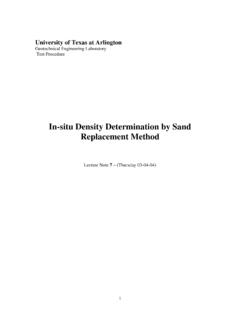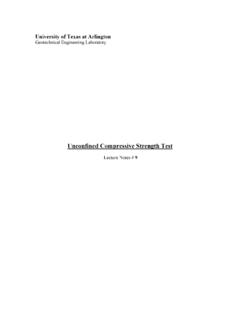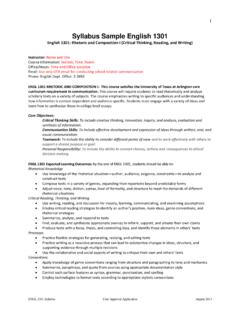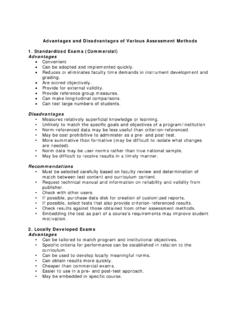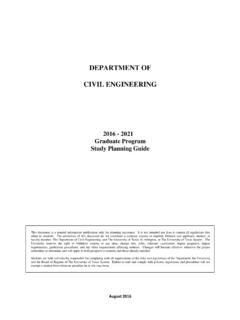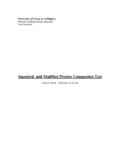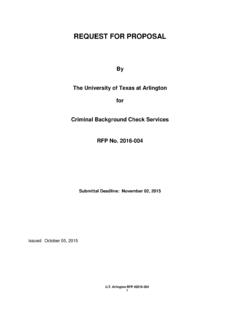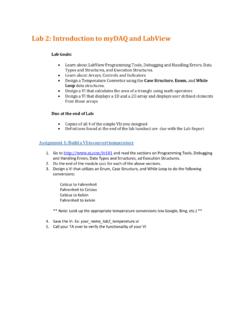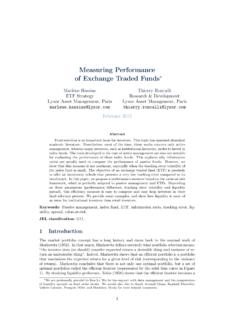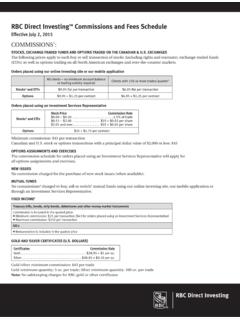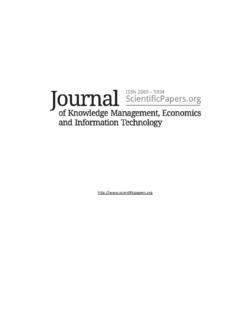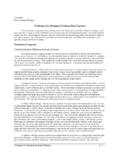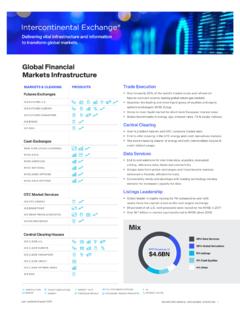Transcription of Exchange Rate Theories - UTA
1 451 TOPICS TO BE COVEREDThe Asset ApproachSterilizationExchange rates and the Trade BalanceOvershooting Exchange RatesCurrency SubstitutionThe Role of NewsForeign Exchange Market MicrostructureKEY WORDSP erfect capital mobilityPortfolio-balance approachSterilized interventionCurrency unionCHAPTER 18 Exchange 10/18/00 3:15 PM Page 451452 Chapter 18 Exchange Rate TheoriesTABLE Deviations of Prices and Exchange Rates1 CountryPriceExchange table reports the standard deviations of the percentage changes in the consumer price index and the spotexchange rate of each country s currency against the dollar for the period March 1990 to March to the monetary-approach emphasis of the 1970s, it was common toemphasize international trade flows as primary determinants of exchangerates. This was due, in part, to the fact that governments maintained tightrestrictions on international flows of financial capital. The role of Exchange ratechanges in eliminating international trade imbalances suggests that we should expectcountries with current trade surpluses to have an appreciating currency, whereascountries with trade deficits should have depreciating currencies.
2 Such exchangerate changes would lead to changes in international relative prices that would workto eliminate the trade recent years, it has become clear that the world does not work in the simpleway just considered. For instance, with financial liberalization we have seen that thevolume of international trade in financial assets now dwarfs trade in goods and ser-vices. Moreover, we have seen some instances where countries with trade surpluseshave depreciating currencies, whereas countries with trade deficits have appreciat-ing currencies. Economists have responded to such real-world events by devisingseveral alternative views of Exchange rate determination. These Theories place amuch greater emphasis on the role of the Exchange rate as one of many prices in theworldwide market for financial assets. This chapter considers some of the recentadvances in Exchange rate ASSET APPROACHM odern Exchange rate models emphasize financial-asset markets.
3 Rather than thetraditional view of Exchange rates adjusting to equilibrate international trade ingoods, the Exchange rate is viewed as adjusting to equilibrate international trade infinancial assets. Because goods prices adjust slowly relative to financial asset pricesand financial assets are traded continuously each business day, the shift in empha-sis from goods markets to asset markets has important implications. Exchange rateswill change every day or even every minute as supplies of and demands for financialassets of different nations implication of the asset approach is that Exchange rates should be muchmore variable than goods prices. This seems to be an empirical fact. Table liststhe standard deviations of percentage changes in prices and Exchange rates for twocountries. In the 1990s period covered in the table, we observe that spot rates 10/18/00 3:15 PM Page 452 Perfect capitalmobilityA situation in whichthere are no barriers tointernational theory of exchangerate determinationarguing that theexchange rate is afunction of relativesupplies of domesticand foreign Asset Approach453*Early classics in the monetary-approach group include Jacob Frenkel, A Monetary Approach to theExchange Rate: Doctrinal Aspects and Empirical Evidence, Scandinavian Journal of Economics (May1976); Michael Mussa, The Exchange Rate, the Balance of Payments, and Monetary and Fiscal Policyunder a Regime of Controlled Floating, Scandinavian Journal of Economics (May 1976); and John Bilson, The Monetary Approach to the Exchange Rate: Some Evidence, IMF Staff Papers(March1978).
4 Some early portfolio-balance classics are William Branson, Hanna Halttunen, and Paul Masson, Exchange rates in the Short Run: The Dollar-Deutschemark Rate, European Economic Review3 (1977);Pentti Kouri and Jorge de Macedo, Exchange rates and the International Adjustment Process, Brookings Papers on Economic Activity1 (1978); Stanley Black, International Money Markets andFlexible Exchange rates , Princeton Studies in International Finance(March 1973); and Polly Allen andPeter Kenen,Asset Markets, Exchange rates , and Economic Integration(New York: Cambridge UniversityPress, 1980).the countries were much more volatile than prices. Comparing the prices with theexchange rates , we find that the volatility of Exchange rates averaged anywhere from4 to 12 times the volatility of prices. Such figures are consistent with the fact thatexchange rates respond to changing conditions in financial-asset markets and are notsimply reacting to changes in international goods rate models emphasizing financial-asset markets typically assume per-fect capital other words, capital flows freely between nations as thereare no significant transactions costs or capital controls to serve as barriers to invest-ment.
5 In such a world, covered interest arbitrage will ensure covered interest rateparity:= where iis the domestic interest rate and ifis the foreign interest rate. Since this rela-tionship will hold continuously, spot and forward Exchange rates as well as interestrates adjust instantaneously to changing financial-market the family of asset-approach models, there are two basic groups: themonetary approach and the portfolio-balance approach.*The monetary approachto the Exchange rate was introduced in Chapter 17. As we stated there, in the mon-etary approach the Exchange rate for any two currencies is determined by relativemoney demand and money supply between the two countries. Relative supplies ofdomestic and foreign bonds are unimportant. The portfolio-balance approach allowsrelative bond supplies and demands as well as relative money-market conditions todetermine the Exchange rate. Table summarizes the differences between thetwo essential difference is that monetary-approach (MA) models assume domes-tic and foreign bonds to be perfect substitutes, whereas portfolio-balance (PB) mod-els assume imperfect substitutability.
6 If domestic and foreign bonds are perfect sub-stitutes, then demanders are indifferent toward the currency of denomination of thebond as long as the expected return is the same. In this case, bond holders do notrequire a premium to hold foreign bonds they would just as soon hold foreignbonds as domestic ones so there is no risk premium, and uncovered interest rateparity holds in MA E Ei if 1 10/18/00 3:15 PM Page 453454 Chapter 18 Exchange Rate TheoriesTABLE Asset Approach to the Exchange RateMonetaryPortfolio-BalanceCharacteris ticApproachApproachPerfect capital mobilityYesYes(implies covered interest rate parity)Domestic and foreign bonds perfect substitutesYesNo(implies uncovered interest rate parity and noforeign- Exchange risk premium)With imperfect substitutability, demanders have preferences for distributingtheir portfolio over the assets of different countries. That is, asset holders have adesired portfolio share for any particular country s assets due to the portfolio diver-sification incentives discussed in Chapter 16.
7 If the supply of one country s assetsincreases, they will hold a greater proportion of that country s assets only if they arecompensated. This requires a premium to be paid on these assets. In general, then,PB models have risk premiums in the forward Exchange rate that are a function ofrelative asset supplies. As the supply of country A s financial assets rises relative toB s, there will be a higher premium paid on A s assets. An implication of this pre-mium is that uncovered interest rate parity will not hold because risk premiums willexist in the forward market. This premium is missing in the MA model because thereit is assumed that investors don t care whether they hold country Aor country Bbonds or in what mix they are might guess that the PB approach is more relevant if we doubt the MAassumption of perfect substitutability of assets internationally. In such cases, wewould view the Exchange rate as being determined by relative supplies of domesticand foreign bonds as well as domestic and foreign money.
8 We may then modify themonetary approach to the Exchange rate equation found in Chapter 17 to incorpo-rate this additional effect. The basic floating Exchange rate MA equation presentedin Chapter 17 is E P F Y D ( )whereE is the percentage change in the Exchange rate, P Fis the foreign inflation rate,Y is the percentage change in domestic income, andD is the percentage change indomestic credit. Equation has the change in the Exchange rate as a function ofmoney supplyD and money demand P F+ Y variables. If domestic and foreign bondsare perfect substitutes, then Equation is a useful MA description of exchangerate determination. The PB approach assumes that assets are imperfect substitutesinternationally because investors perceive foreign- Exchange risk to be attached toforeign-currency-denominated bonds. As the supply of domestic bonds rises relativeto foreign bonds, there will be an increased risk premium on the domestic bondsthat will cause the domestic currency to depreciate in the spot market.
9 If the 10/18/00 3:15 PM Page 454 Sterilization455*Several researchers have shown that it is difficult to demonstrate that one model of Exchange ratedetermination clearly dominates all others. An example is Ronald MacDonald and Mark P. Taylor, Exchange Rate Economics: A Survey, International Monetary Fund Staff Papers(March 1992). Exchange rate depreciates today, and if the expected future spot rate is unchanged,the expected rate of appreciation (depreciation) over the future increases (decreases).For instance, if the dollar-pound spot rate is initially E$/ = and the expectedspot rate in one year is E$/ = , then the expected rate of dollar appreciation is 5percent [( ) ]. Now, suppose an increase in the outstanding stock ofdollar-denominated bonds results in a depreciation of the spot rate today to E$/ = The expected rate of dollar appreciation is now approximately percent[( ) ].If the spot Exchange rate is a function of relative asset supplies, then the MAequation, Equation , should be modified to include the percentage change in thesupply of foreign bonds BFrelative to the percentage change in the supply of domes-tic bonds B: E = PF Y D BF B( )An increase in foreign-bond supplies BFcauses the domestic currency to appreciateat a faster rate ( falls) or depreciate at a slower rate.
10 An increase in domestic-bondsupplies Bcauses the domestic currency to depreciate at a faster rate ( E increases) orappreciate at a slower rate. This broader PB view might be expected to explainexchange rate changes better than the MA equation, Equation However, theempirical evidence is not at all clear on this matter.* One potential problem for ana-lyzing the MA and PB models of Exchange rate determination is central-bank activ-ities aimed at insulating the domestic money supply from international events. Thenext section discusses the importance of this recent years, an important topic of debate has emerged from the literature on themonetary approach regarding the ability of central banks to sterilize reserve refers to central banks offsetting international reserve flows to followan independent monetary policy. Under the monetary approach to the balance ofpayments (with fixed Exchange rates ), if a country had an excess supply of money,this country would tend to lose international reserves or run a deficit until moneysupply equals money demand.
